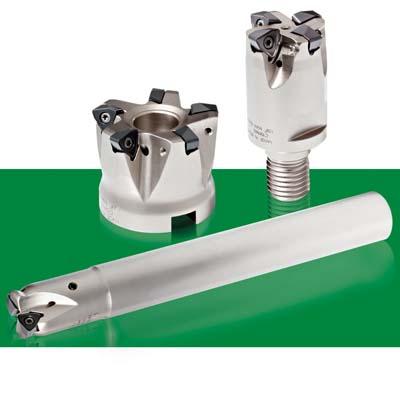
Successful high-feed milling is characterized as using small depths of cut at high federates per tooth, with the result being higher metal-removal rates and increased productivity. As opposed to traditional milling, high-feed milling generates lower radial cutting forces, making it an attractive concept for roughing, copy milling, profile milling, and other applications necessitating quick removal of metal, even where longer reach is required. WIDIA is introducing two new insert families specifically designed for successful high-feed milling: the M270 Series and M370 Series. WIDIA M270 inserts are designed based on WIDIA-Hanita X-Feed geometry.
"This is a proven edge and geometry for high-feed machining, with good results across a range of materials," says Juan Seculi, Global Product Manager, Indexable Milling at Kennametal.
Three grades are available: TN2505 for good wear-resistance in materials up to 60 HRC hardness; TN6540 for added toughness; and TN6525, a mix of toughness and wear-resistance for dry-machining applications in steel. Two contact faces in a V-shaped pocket design help ensure the secure and rigid insert clamping and accurate insert positioning that improves cutting performance and tool life.
The WIDIA M370 Series is a double-sided high-feed concept that combines the latest in insert technology with outstanding performance and reliability for steel, stainless steel, and cast-iron milling. Designed for high-feed-rate productivity, its double-sided concept and six cutting edges provide security and optimal metal removal with an efficient cost per edge.
"The M370 Series features an MH geometry offering the protection of a flat-top insert, but with reduced cutting forces, and anmm geometry specifically for stainless steel, or optimization where even lower cutting forces are required," Seculi says. "Even running at existing parameters, the M370 offers longer tool life and free-machining characteristics."
Both M270 and M370 Series are available in inch and metric sizes.
Contact Details
Related Glossary Terms
- gang cutting ( milling)
gang cutting ( milling)
Machining with several cutters mounted on a single arbor, generally for simultaneous cutting.
- milling
milling
Machining operation in which metal or other material is removed by applying power to a rotating cutter. In vertical milling, the cutting tool is mounted vertically on the spindle. In horizontal milling, the cutting tool is mounted horizontally, either directly on the spindle or on an arbor. Horizontal milling is further broken down into conventional milling, where the cutter rotates opposite the direction of feed, or “up” into the workpiece; and climb milling, where the cutter rotates in the direction of feed, or “down” into the workpiece. Milling operations include plane or surface milling, endmilling, facemilling, angle milling, form milling and profiling.

